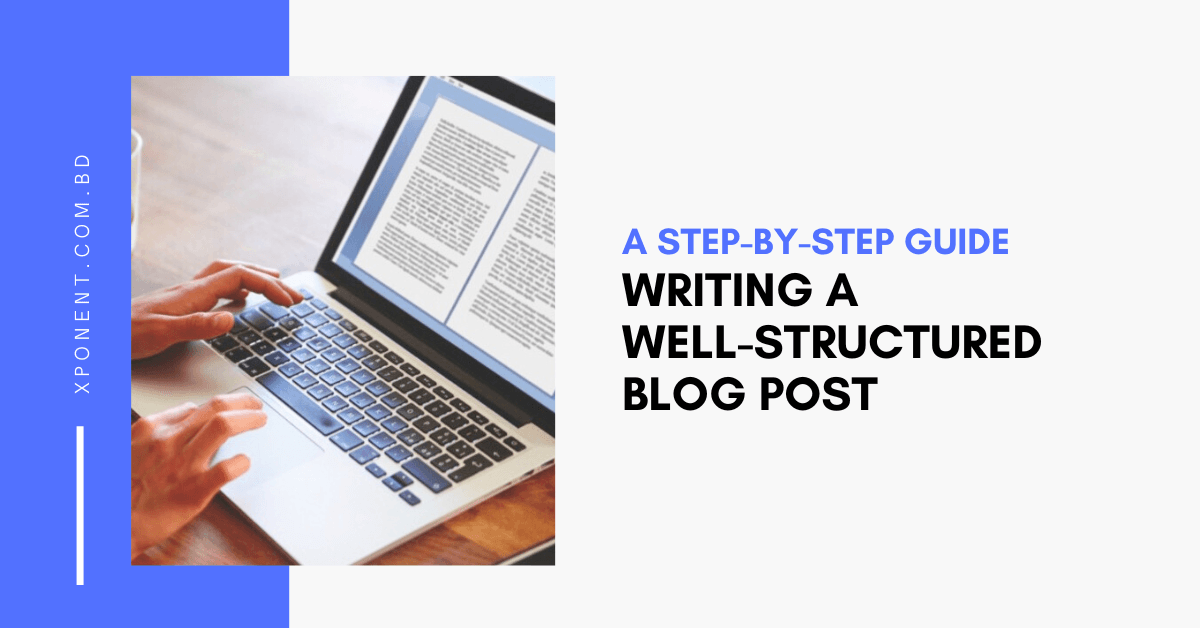Writing a Well-Structured Blog Post: A Step-by-Step Guide

Are you looking to increase your website’s pageviews and engagement? Well-structured blog posts may be the solution. In this guide, we’ll walk through the steps to writing effective and engaging blog posts.
What is engaging blog post?
Engaging blog posts are those that capture and hold the attention of readers, encouraging them to continue reading and interact with the content. Engaging blog posts are well-written, informative, and often entertaining or thought-provoking. They typically include a strong and relevant headline, an attention-grabbing introduction, and clear, concise writing that is easy to understand.
Engaging blog posts also tend to:
- Be visually appealing: Including images, videos, or infographics can help break up the text and keep readers engaged.
- Use storytelling: Engaging blog posts often include anecdotes or personal stories that help readers connect with the content on a deeper level.
- Be actionable: Providing practical tips, actionable advice, or useful insights can help readers feel like they are learning something valuable.
- Be interactive: Including elements that encourage readers to interact with the content, such as surveys, quizzes, or polls, can increase engagement and make the post more memorable.
- Be shareable: Engaging blog posts often include information or insights that readers will want to share with others, whether on social media or through other channels.
Overall, engaging blog posts are those that capture the reader’s attention, provide value, and leave a lasting impression.
Step 1: Answer the search query in the first 4 paragraphs.
The perfect blog post should answer the search query in the first 4 paragraphs. This means readers won’t have to scroll endlessly to find answers. To achieve this, use a classic journalistic technique called The Inverted Pyramid. The top line of the pyramid should be your hook, followed by pressing on the reader’s pain points, answering the target keyword directly, and wrapping up what they’ll learn in the rest of the article.
Step 2: Use the Inverted Pyramid technique
With a twist In journalism, the top line of the pyramid features the 5 W’s: Who, What, Where, When, Why. However, in blogging, the top line should be your hook. Forget about the 5 W’s and focus on creating a hook that will grab the reader’s attention.
Here are some resources to learn more about the Inverted Pyramid technique:
- “The Inverted Pyramid: Writing for Comprehension” by the American Press Institute – https://www.americanpressinstitute.org/journalism-essentials/writing-and-editing/write-for-the-web/inverted-pyramid/
- “The Inverted Pyramid: How to Structure Your Articles for Maximum Impact” by Neil Patel – https://neilpatel.com/blog/inverted-pyramid/
- “What is the Inverted Pyramid?” by The Balance Small Business – https://www.thebalancesmb.com/what-is-the-inverted-pyramid-2294858
- “Writing News Stories: The Inverted Pyramid” by ThoughtCo – https://www.thoughtco.com/inverted-pyramid-1692858
These resources provide a comprehensive understanding of the Inverted Pyramid technique, including its history, benefits, and how to use it effectively in your writing.
Step 3: Get inside the mind of the reader
Before you start writing, think about the reader’s search intent. What do they want to know? For example, if your target keyword is “Are Apple watches waterproof?” someone typing this into Google likely wants to buy or already owns an Apple watch, likes swimming/watersports, and doesn’t want to ruin their watch or pay for a replacement.
Here are some resources to learn more about understanding reader’s search intent:
- “How to Understand Search Intent and Use It to Boost SEO Rankings” by Moz – https://moz.com/blog/understanding-and-fulfilling-search-intent
- “A Complete Guide to Understanding Search Intent for SEO” by Search Engine Journal – https://www.searchenginejournal.com/search-intent-seo/416853/
- “How to Optimize Your Content for Google’s Featured Snippet Box” by HubSpot – https://blog.hubspot.com/marketing/featured-snippet-box
- “Google’s Four Stages of Intent: How to Satisfy Searchers at Every Stage” by Search Engine Land – https://searchengineland.com/googles-four-stages-intent-satisfy-searchers-every-stage-275713
These resources provide insights on how to analyze and understand reader’s search intent, and how to use this information to create content that addresses their needs and interests. They also provide tips and strategies for optimizing your content for featured snippets and improving your search engine rankings.
Step 4: Write an effective intro
Your intro should have a hook, press on the reader’s pain points, answer the target keyword directly, and wrap up what they’ll learn in the rest of the article. Avoid using the exact target keyword in the intro and keep it to no more than 250 characters. Encourage the reader to keep scrolling by giving a glimpse of what they’ll learn in the rest of the article.
some links to learn about writing an effective introduction:
- How to Write an Introduction: A Beginner’s Guide (https://www.scribbr.com/academic-essay/introduction/)
- Writing an Introduction (https://www2.le.ac.uk/offices/ld/resources/writing/writing-resources/introduction)
- 10 Ways to Write an Irresistible Intro to Your Blog Post (https://copyblogger.com/irresistible-blog-intro/)
- Introductions (https://writingcenter.unc.edu/tips-and-tools/introductions/)
- How to Write a Good Introduction Paragraph (https://www.youtube.com/watch?v=DTMlHbzrMzE)
Step 5: Break up text with images, dot points, and tables/data
To keep the reader engaged, break up the text with images, dot points, and tables/data. This will also make your post easier to read and understand.

Step 6: Repeat the process throughout the rest of the article
Once you’ve completed the first 4 paragraphs, repeat the process throughout the rest of the article. Use the Inverted Pyramid technique with a twist, get inside the mind of the reader, and break up the text with images, dot points, and tables/data.
By following these steps, you’ll be on your way to writing effective and engaging blog posts that will keep your readers coming back for more.
Learn more:
- How to Write SEO-Friendly Blog Posts (https://www.hubspot.com/blog-writing-guide)
- The Ultimate Guide to SEO-Friendly Blogging (https://www.searchenginejournal.com/seo-friendly-blogging-guide/352840/)
- How to Write Blog Posts That Rank in 2021 (https://neilpatel.com/blog/how-to-write-blog-posts-that-rank/)
- The Ultimate Guide to Writing Blog Posts That Rank in 2021 (https://blog.hubspot.com/marketing/how-to-write-a-blog-post)
- The Anatomy of a Perfect Blog Post That Google Will Love (https://www.quicksprout.com/blog-anatomy/)

